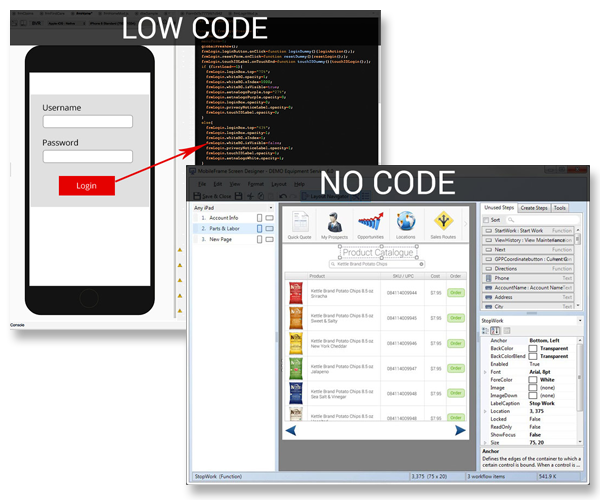Excellent Ideas To Choosing Low-code platforms for application development
Wiki Article
The Benefits Of Low-Code Development To Speed Up Development
Visual Development Environment (VDE):
Drag-and-Drop Interfaces: Low-code platforms provide visual tools for designing applications. Developers can build an application using drag-and-drop elements without having to write code.
Templates and components that are pre-built A lot of low-code platforms include pre-built components and templates, which allow developers to quickly prototype and create applications.
Reduced Coding Needs:
Automated Code Generating: The low-code platform automatically generates the code underneath based upon the visual models that developers create. This reduces the need for manual coding and improves the speed of development.
Reusable Parts Developers will have the ability to reuse reusable parts across different projects, and cut down on the time needed for writing and testing code.
Streamlined Collaboration:
Low-code platform tools often contain versions control, testing, or deployment. This facilitates seamless collaboration between teams.
Citizen Development (Citizen Development) User and non-developers of business applications are able to participate in the development of applications using user-friendly interfaces. This reduces the bottleneck caused by the limited professional developer availability.
Rapid prototyping, rapid iteration, and rapid prototyping
Rapid prototyping: Designers can quickly design prototypes in order to collect feedback and confirm ideas, resulting in faster cycles of iteration.
Easy Modifications – The visual nature of low-code development permits for easier changes and updates which speed up the refining of applications based upon user feedback.
Pre-built Integrations:
API Integrations. A lot of low-code platforms have connectors designed for the most well-known APIs and services. This could reduce the time to integrate systems.
Data Integration: The built-in tools make it easier for connecting with databases and other sources, speeding up the process of development.
Deployment, scaling and deployment
One-Click-Deployment: Many Low-Code platforms provide one-click option for deployment. This cuts down on the time and efforts required to set up an application.
Cloud-based solutions: Cloud platforms with low-code enable developers to focus on the logic and functionality of their applications rather than worrying about logistics for deployment.
The most significant benefit of low-code application development, in terms of speed, is the ability to automate and simplify many aspects in the development process. This allows for quicker delivery of applications and quicker adaptations to changing demands. Check out the top Low-code Platform for application development for site tips including sso azure, application development platforms, sso azure, mobile development platforms, ms azure sql, push alerts, jdbc server, low code platforms, app platforms, develop mobile application and more.

Cost-Effectiveness Is One Of Many Benefits Of Creating Applications With Low-Code.
Low-code development offers many advantages in terms of cost effectiveness. This makes it an ideal choice for companies who want to maximize their development budgets while still providing top quality software. These are the major benefits reduced development costs
Less Coding Requirements: The low codes platforms remove the need for extensive hand-coded, custom-built applications. Developers will take less time and energy building applications. This results in less labor costs.
A smaller number of developers: Since low code development is speedier and simpler to develop, there are less specialized developers needed. This could significantly cut down on costs for hiring and staffing.
Speedier time to market
Accelerated Development Cycle: The visual development tools and pre-built components offered by low-code platforms enable rapid development of applications, which allows companies to get their products on market faster. This can result faster revenues, as well as improved standing in the market.
Rapid Prototyping. By quickly creating and testing prototypes, companies can speed up development and iterate faster based upon user feedback.
Lower Maintenance Costs:
The modular architecture and standardized components of applications built on low-code platforms make them easier to maintain. This lowers the costs of ongoing maintenance.
Automated updates: A lot of low-code platforms automatically manage updates and patches, making sure that the applications are safe and up-to-date with no need for extensive manual intervention.
Efficient Resource Utilization:
Contributions by non-developers: Low-code platforms enable non-developers for example, business users to be a part of the development process. This democratization allows businesses to use the skills of many employees and reduce their dependency on highly-paid programmers.
Optimized use of IT resources IT departments get the ability to focus on more strategic projects, instead of getting bogged down with simple work tasks for development. Overall efficiency and productivity improves.
Scalable pricing models:
Subscription pricing: Many low-code platforms provide different subscription pricing options that can be scaled according to usage. Businesses are able to match their spending to their needs and growth without the need for large upfront costs.
Pay-As You-Go: Some platforms provide pay-as-you-go options. This allows businesses to only pay for resources that they actually need. This is especially beneficial for small and new businesses with a limited budget.
Reduced Third-Party Software Costs:
Built-in Functionalities: Low code platforms have a variety of built-in features and integrations, which reduce the need for third-party tools and software. Subscription fees and licensing fees are also reduced.
Pre-Built Integrations: The existence of pre-built integrations for popular services and systems minimizes the requirement for custom development, thereby saving time and money.
Improved ROI
Faster Return On Investment: A combination of rapid development and lower costs with speedier time to market will allow businesses to earn more return on investment.
Improved agility: Companies can adapt quickly to changes on the market or to customer demands and this allows businesses to stay relevant and benefit from new opportunities.
The cost of training is lower:
User-Friendly Interfaces: Low-code platforms are user-friendly and have simple interfaces, which reduces the learning curve.
Accessible Resources A lot of low-code platforms provide complete training materials, tutorials, and community support, further lessening the requirement for formal education and associated costs.
Streamlined Collaboration:
Enhanced collaboration tools Collaboration tools are integrated into the workflow. This allows better communication between team members and the reduction of project overhead.
Unified Development Environment : A unified environment makes work easier and reduces the costs that are associated with managing different platforms and tools.
In general, low-code apps are cost-effective due to their ability to cut costs for development and maintenance as well as to speed time-to-market, to optimize resource usage and also to offer flexibility in pricing. These aspects provide significant economic benefits to companies. Low-code is a fantastic option for businesses that want to maximize budgets but still build robust, scalable, and high-quality software. Follow the recommended Legacy application modernization with Low-code advice for more tips including developing mobile apps, paas service, developing mobile apps, build with docker, rad application development, app modernisation, azure sql, stored sql procedures, jdbc server, mobile app development platforms and more.

The Benefits Of Developing Applications Using Low-Code For Collaboration And Workflow
The low-code approach to development of applications has several benefits in regards to workflow and collaboration, which makes it an ideal option for businesses looking to boost team productivity and streamlining their development processes. Here are a few advantages.
Unified Development Environment (UDE): Low-code platforms provide one, unifying development environment that enables everyone on the team including developers as well as business analysts to collaborate efficiently. This eliminates barriers.
Visual Development Tools: The visually drag-and-drop design of low-code tools makes it simpler for non-technical team members participate in the development process, ensuring that the requirements of the business are correctly captured and implemented.
Communication Enhancement
Real-Time Collaboration: Many low-code platforms have real-time collaboration features, such as simultaneous editing, commenting and instant feedback. These features facilitate continuous communication and reduce the amount of time that is spent in back-and-forth conversations.
Workspaces shared by teams have the ability to collaborate on shared workspaces where they can modify and discuss project components. This will ensure that everyone is working towards the same goals and is on the exact same page.
Streamlined Workflow Management:
Project management tools built-in: Low-code platforms usually come with project management tools integrated that allow teams to organize, track and manage their projects. This includes tasks assignment tracking progress, task assignment, and deadlines management.
Workflow Automation - Automating routine tasks or workflows permits teams to focus their efforts on more strategic initiatives and tasks which improve the overall efficiency of an organization.
Speedier iteration cycles:
Rapid prototyping. Low-code platform enables quick prototyping. This allows feedback to be incorporated quickly and changes implemented quickly.
Support for agile development: Supporting agile practices allow teams to be continuously working in sprints. This makes it easier to adapt and deliver small steps to improve functionalities.
Accessibility for non-developers
Citizens Development: Lowcode platforms permit people who use business software (citizen developers) to design, modify, and maintain applications that do not require a lot of code. This reduces the workload of IT and development teams and lets them respond faster to business needs.
Onboarding and training: The intuitive user interfaces and extensive training materials aid in bringing new members of the team up to speed. This enhances overall cohesion of the team.
Centralized Documentation and Knowledge Sharing:
Documentation integrated Platform features that are low-code usually permit you to create and manage documents on the platform. All information about your project will be centralized and easily accessible.
Knowledge Repositories : Teams are able to create knowledge repositories, which contain templates, best practices and reuseable components. This helps in sharing knowledge and reduces duplication of efforts.
Consistency and Standardization
Standardized Components : The use standardized components that are pre-built and built provides an enduring consistency across the different applications. This makes it easier for the members of the team to grasp the different components of a given project and then work on them.
Governance and Compliance - The built-in governance frameworks make sure that the creation process of all applications conforms to the organizational standards as as the regulatory standards. This helps to reduce non-compliance risk and assures that applications comply with the highest quality standards.
Feedback and Improvement:
Integrated Feedback mechanisms: Platforms with low-code typically have a built-in feedback mechanisms, which allow users to give their feedback on applications. Feedback can then become incorporated into development.
Continuous Improvement: The capability to rapidly iterate on and then deploy modifications as a result of feedback allows for continuous improvement of applications. They are closely aligned with the needs of users and goals of the business.
Visualization and Reporting:
Real-Time Analyses: The built-in reports and analytics tools offer instantaneous insight into the project's performance, progress and user interaction, allowing for data-driven decisions.
Visual Workflow Analysis Visual tools are utilized to map processes and workflows. These tools help teams identify and improve their workflows.
For collaboration, low-code software is a great way to streamline workflows, bring diverse teams together, and automate tasks. This creates a more flexible, efficient and collaborative environment for development. This ultimately results in better-quality applications as well as better alignment of business goals.
